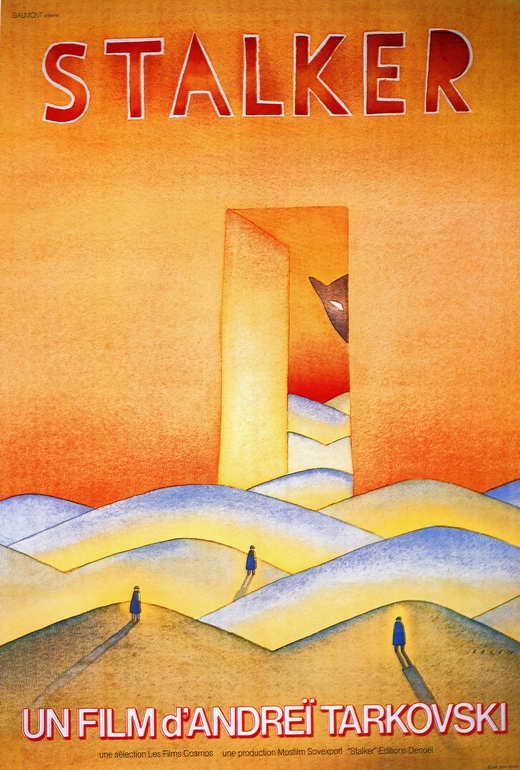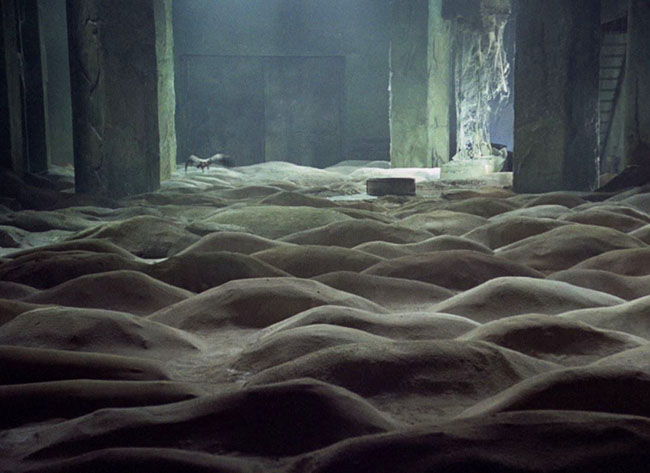
The Zone, in Andrei Tarkovsky’s Stalker (1979), is a region affected by a fallen meteorite in ways that are left deliberately undefined. It is an otherworld, a displaced and eerily altered stretch of swamp and forest and derelict buildings and sewers. Within, abandoned tanks seem to exist in a state of unnatural decay. A railroad extends from the nearby militarized city into the Zone’s reeds and weeds and overpowering silence. The only landmark of note is a place called the Room, which lies within an impassive structure that seems within easy reach. Except it’s not that easy, as the Stalker (Aleksandr Kaidanovsky, At Home Among Strangers) informs the two men he’s led into the Zone. This empty landscape is filled with invisible traps. The only way to get to the Room is to weave back and forth, following a labyrinth whose paths are defined by wherever Stalker randomly throws a cloth weighted by a metal nut. Stalker claims that the Room has the ability to grant one’s deepest desires, a promise that’s highly dubious but with implications that begin to feel ominous to the travelers. What will their desires reveal about who they truly are? Do they really want to set foot inside the Room, if everything that Stalker says is true? He tells them that his father, who taught him the profession, entered the Room and soon became a wealthy man; he hanged himself anyway.
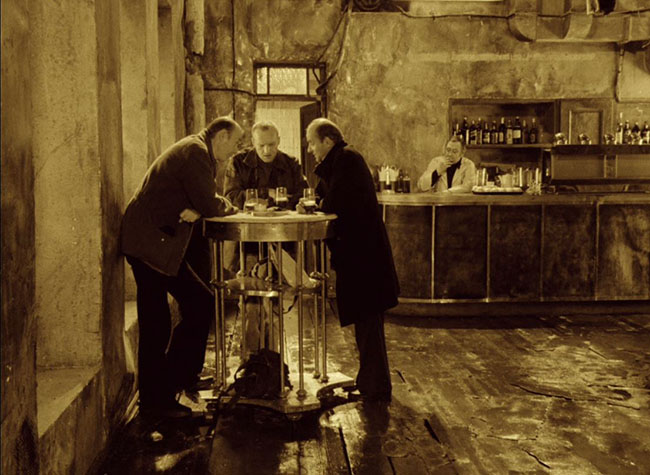
The Professor (Nikolai Grinko) and the Writer (Anatoli Solonitsyn) discuss following Stalker (Alexander Kaidanovsky) into the Zone.
Tarkovsky’s last Soviet film is a companion piece of sorts to Solaris (1972), his brilliant (and long) adaptation of Stanislaw Lem’s classic science fiction novel. Stalker is a brilliant (and long) adaptation of a different SF novel, Roadside Picnic by Boris and Arkady Strugatsky. The source material has been more heavily reworked from the original in this case, a situation partially necessitated by production woes: Tarkovsky intended to shoot in the mountainous Tajikistan but was forced to relocate to Tallinn, Estonia, following an earthquake, filming around power plants and chemical factories. After completing most of the outdoor shots, the film was improperly developed in the lab, resulting in unusable footage. Tarkovsky fired his DP and started over from scratch. Meanwhile, the script became a loose adaptation of the novel, as the director, through his usual methodology, stripped plot and characters down to bare essentials, allowing space for the Tarkovskian extended, brooding, often wordless takes – and space for the viewer to truly enter a “zone.” The film is just over two hours and forty minutes, but it stretches time, creates its own altered temporal space through beautiful photography and almost magical movements inside the frame, and yes, this means that if you’re not in the right frame of mind it can be a slog. For a while, Stalker is a slog. But if you watch without distraction, and you are open to it, something happens, an effect which is par for the course with Tarkovsky. You reach a meditative state. You’re transfixed, invested in the sensuality of his images – even though the palette of Stalker is one of rusting industrial sites and environmental pollution. (It is widely believed that filming in these conditions led to the premature deaths of various crew members, including Tarkovsky himself.)
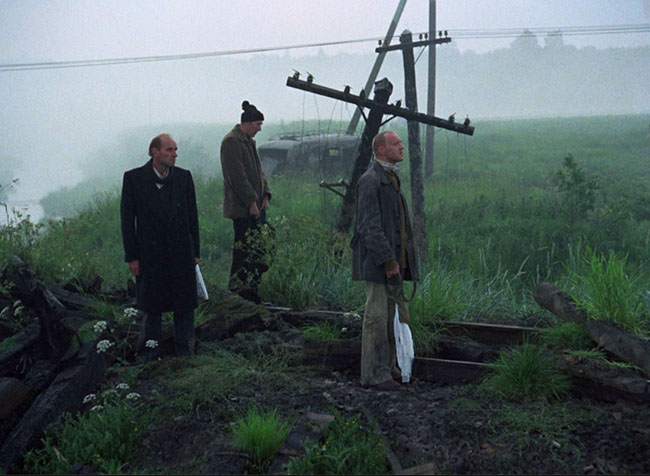
In the Zone.
Most fascinating about Tarkovsky’s long-take approach is that it allows an invisible presence to enter the film like a spiritualist’s summoning: the Zone, which may or may not be supernatural/extraterrestrial. The single overtly elevated aspect to the Zone is something only our eyes can see: the Zone is in color. Wizard of Oz-like, we leave a sepia-toned monochrome world. But everything important in Stalker is invisible to the characters; and the invisible is life-or-death important. In other words, Stalker is about faith. Late in the film we learn a very critical fact – that everything we think we know about the Zone comes from Stalker, and everything he learned comes from his father. It’s a cult-like, insular womb of belief which, by now, has completely encased the two outsiders, the Professor and the Writer (Nikolai Grinko and Anatoli Solonitsyn, both Tarkovsky regulars who also appeared in Solaris). Yet early on the Writer expresses extreme skepticism for the Zone – confounded by Stalker’s at-random approach to navigating this seemingly straightforward landscape, he attempts to walk straight to the building containing the Room. Such a simple act of rebellion almost destroys Stalker. It’s important to follow the rules, to respect the Zone. The Writer is brought up short by a disembodied voice telling him to stop. Shuddering, he turns and walks back. He asks the others why they told him to stop, though we can see he doesn’t truly believe the voice came from them. Stalker suggests that the Writer spoke the words himself. Nevertheless, the Writer begins to respect the Zone. He fears for his life late in the film after drawing the short lot and being compelled to walk through a tunnel, “the Meat Grinder,” which leads to the Room. But there is never any visual evidence that he’s in danger. Tarkovsky shoots this scene as one long walk and the suspense is claustrophobic; it might as well be a horror film. There’s nothing there. In a chamber beyond, a surreal room (not the Room) is filled with sand dunes. A bird flies through the room, and in a jump cut/retake flies through again. Did we see that, was it just a filmmaker’s flourish, or are we really in a place where the rules of reality don’t apply? Should Tarkovsky show you what’s in the Room, or should he hold it back so you can sketch in its geometry with your own faith (or lack of it)? He positions the camera inside the Room and points it back at the three characters struggling to decide whether they should really enter, wondering what that might mean for them to have their innermost selves exposed by the Room.
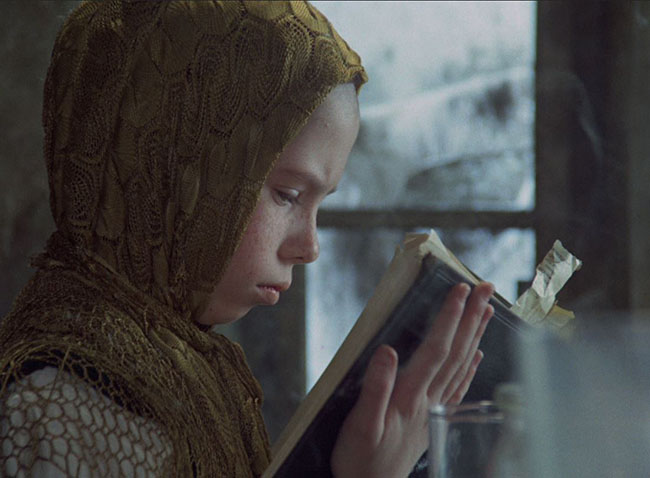
Monkey (Natasha Abramova), Stalker’s daughter.
The Professor is not what he seems to be, and even the Writer shows shades of character previously unrevealed by his womanizing and drinking. But it’s Stalker who remains the center of the film and its most fascinating, fully-realized human. In the aftermath of his journey into the Zone – which is really a pilgrimage – he is shaken to his core, questioning his faith, demanding that the Zone mean as much to others as it does to him. He’s in existential crisis that his life might have been a waste, built as it is on a yarn his father told him. His struggle mirrors Tarkovsky’s, who builds Stalker one laborious step at a time like the bell-making in his early masterpiece Andrei Rublev (1966), who reconstructs Stalker even after his first attempt at the film is destroyed in the photo lab. We can bring knowledge to a screening that Tarkovsky and his crew saw their health suffer from shooting in the chemical wastes of the real-life Zone, and this only adds to the uniquely Catholic (or Russian Orthodox) feeling of sacrifice and suffering. It invests the images of detritus and scorched or drowned ephemera over which Tarkovsky’s camera lovingly drifts; these scattered items in the industrial ruins seem to hold cryptic meanings, like sacred artifacts from lost races. And in the final moment of the film, while “Ode to Joy” plays in a far-off radio’s militaristic march, we see Stalker’s daughter, crippled from his repeated trips to the Zone, prove to us that sometimes the invisible can invade our reality in miraculous form.
Stalker was released earlier this year from the Criterion Collection in a 2K digital restoration which puts all former home video releases to shame – it’s highly recommended.
